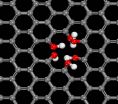The first conifer species that produced seeds that whirl when they fall used a variety of single- and double-winged designs. Whirling, or helicoptering, keeps a seed aloft longer, increasing the chance that a gust of wind will carry a seed to a clearing where it can sprout and grow unimpeded by competitors
"Winged seeds may have contributed to the success of these conifers," said paleobotanist Cindy Looy, an assistant professor of integrative biology at UC Berkeley, a member of the Berkeley Initiative for Global Change Biology (BiGCB) and a curator with UC Berkeley's Museum of Paleontology.
Today, however, all conifer species whose seeds whirl as they fall appear to have settled on only one type of design: asymmetrical and single-winged. Several different conifer lineages independently came upon this single-winged design after experimenting with helicoptering winged seeds over millions of years of evolution.
To convince herself that later conifers settled on the most efficient design for windborne seed dispersal, Looy and her colleagues built model seeds inspired by the variety of seed designs found in a unique collection of 270 million-year-old fossil seeds from Texas.
By dropping these model seeds and filming their descent with high-speed cameras, they demonstrated that whirling, single-winged seeds were the most effective at aerial dispersal. Symmetric, double-winged seeds often failed to initiate the descent-slowing spin, but even if they did, they remained airborne only half as long as the single-winged ones.
Moreover, the difference in flight performance of single-winged whirling seeds and asymmetrical or symmetrical double-winged ones increased with increased seed weight or in turbulent air.
Looy, former research assistant Robert Stevenson and former graduate student Dennis Evangelista, now at the University of North Carolina at Chapel Hill, will publish their experimental findings in a featured article in the March 2015 issue of the journal Paleobiology.
Looy has been studying fossils of early conifer groups from deposits in Texas dating to the Permian Period, about 270 million years ago. She was struck by the fact that one of the conifer species produced a range of seed shapes, ranging from single-winged to asymmetrical and symmetrical double-winged seeds
This is unusual, she said, because the single-winged seeds have the clear advantage of enhanced dispersal efficiency, especially during the Permian when seed dispersal by animals was virtually absent. Even more unusual was the fact that different conifer species that independently evolved whirling, or autorotating, seeds ended up with only one optimal seed shape up in today's conifer species. The same is true for other trees that developed similar seeds or fruits, such as the maple and ash.
The Permian conifer, which she and Stevenson formally described last year and named Manifera talaris, produced the oldest known autorotating conifer seeds roughly 40 million years before dinosaurs evolved.
"Rotating seeds in living conifers are generally asymmetrical and single-winged, so I wondered if the function of the double-winged seeds was very different," she said. "Until you actually see them in action and compare them, you don't have any proof."
Paper wings and plastic seeds
Looy knew that people had tested the aerodynamics of single-winged, autorotating seeds, but no one had ever studied the other designs because they aren't found today. Using special tissue paper for wings and plastic film for the heavy seed, she and her colleagues built models of the single-winged seeds of a living conifer that resembled those of the fossil conifer. The actual seeds of this tree, the New Zealand kauri (Agathis australis), were used to confirm that the fabricated models behaved like the real thing.
They then altered the design of the models to match the symmetric and asymmetric double-winged as well as the single-winged seeds common among the Texas fossils. The researchers dropped the seeds from a height of 3 meters (9 feet) and filmed their fall with a high-speed camera. This enabled them to observe the flight performance and measure a range of flight characteristics and aerodynamic properties of the various shapes. They enlisted half a dozen UC Berkeley undergraduates to help determine which type of winged seed works best for wind dispersal and to digitize the flight behavior of the seeds captured on camera.
They found that, in contrast to the single-winged seeds, the symmetric and asymmetric double-winged seeds did not spin as effectively; instead of a slow helicopter descent, they usually fluttered or just plummeted to the ground. But even when seeds with double-winged shapes managed to autorotate, the experiments demonstrated conclusively that single-winged seeds stayed airborne almost twice as long.
Early seed dispersal
Air- and waterborne seeds became more common between the late Carboniferous - 320 million years ago - and early Permian, which began about 300 million years ago. At the time, most plant life consisted of lycopods, ferns, horsetails and seed ferns, with a few of the first cone-bearing trees, like conifers and cycads, appearing.
"There were very different plants around at the time," Looy said. "Several of these groups produced seeds, but they lacked most of the tricks we see today to spread them."
Vertebrates, only a few of which were herbivores, were typically large and did not climb trees. The only flying animals were insects, and as far as we know they did not disperse seeds, Looy said.
"For a seed at that time, having wings was actually one of the few ways to spread widely," she said.
The conifer fossils, which are from north-central Texas, date from a time when Texas was located near the equator, and North America was part of the massive continent of Pangea. Looy studied these fossils when she worked as a postdoctoral researcher at the Smithsonian Institution from 2004 to 2008, and was struck by the seed variety within a single species compared to today.
"In these conifers you can see steps from making winged seeds to making autorotating seeds. It seems that the Permian conifer Manifera first figured out how to produce a range of winged seed shapes -including the highly functional autorotating ones," she said. "However, fossils of closely related end-Permian conifers suggest that it wasn't until much later that they discovered how to not produce the less functional types. Around that time, we also see the first slightly succulent conifer seeds appearing in the fossil record, which are attractive to animals and potentially indicative of animal dispersal. Slowly the seeds start to diversify to all the different types we have nowadays."
INFORMATION:
This research was supported by the Hellman Fellowship, the UC Berkeley Museum of Paleontology and the UC Berkeley Undergraduate Research Apprentice Program.




